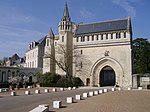Lycée Vaucanson (Tours)
1989 establishments in FranceBoarding schools in FranceBuildings and structures in Tours, FranceEducation in Tours, FranceEducational institutions established in 1989 ... and 2 more
French school stubsLycées in Indre-et-Loire
Lycée Jacques de Vaucanson is a senior high school/sixth-form college in Tours, Indre-et-Loire, France. It opened in 1989 and moved into a new building in 2012.The school includes a boarding facility.
Excerpt from the Wikipedia article Lycée Vaucanson (Tours) (License: CC BY-SA 3.0, Authors).Lycée Vaucanson (Tours)
Rue Védrines, Tours Sainte-Radegonde
Geographical coordinates (GPS) Address Nearby Places Show on map
Geographical coordinates (GPS)
| Latitude | Longitude |
|---|---|
| N 47.4236 ° | E 0.7068 ° |
Address
Lycée général et technologique Jacques de Vaucanson
Rue Védrines 1
37100 Tours, Sainte-Radegonde
Centre-Val de Loire, France
Open on Google Maps










